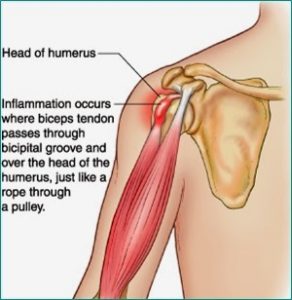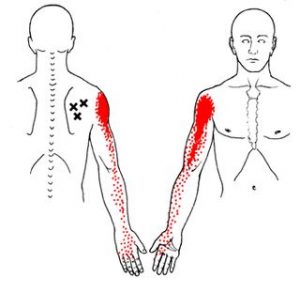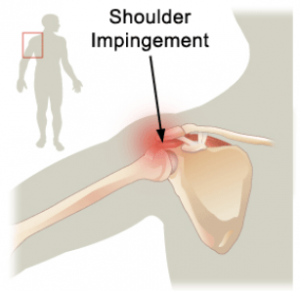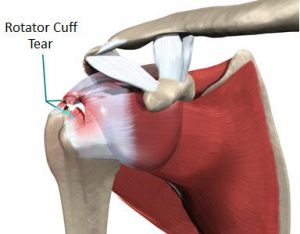7 Common Reasons Why You Have Shoulder Pain
 By: Dr. Rachel Jakubowski
By: Dr. Rachel JakubowskiPhysical Therapist
SPECTRUM, Inc
Shoulder pain is one of my favorite issues to treat. For me, shoulder pain is easy to treat. Why? Because there are a lot of commonalities among individuals that come to me with shoulder pain, no matter what type of shoulder pain it is. No, not everyone with shoulder pain will have the same exact 3 or 4 problems; which is why an extensive examination is necessary before I start treating someone. However, I still find that most of my shoulder pain patients have a few things in common. Listed below are the top 7 dysfunctions I see in my shoulder patients:
1. Restricted pectoralis minor/major flexibility
2. Restricted latissimus dorsi flexibility
3. Trigger points (muscle knots) that refer pain into the shoulder
4. Forward head and shoulder posture
5. Overactivation of the upper trapezius muscles
6. Weak scapular retractors, core, and rotator cuff muscles
7. Poor motor control
There are easy ways to treat each of these issues and I have provided some exercises at the end of the blog.
Next I want to talk about some common diagnoses I hear when a patient walks into my facility.
 Pain in the biceps or the front of the shoulder: A lot of times people come in with pain in the front of the shoulder and have been told they have a biceps tendonitis/tendonapathy. If you hear this diagnosis it means your biceps tendon has taken on extra work because your rotator cuff muscles, your scapular stabilizers and your core are slacking on the job. Other common issues found with this diagnosis include: restricted thoracic mobility, and slouchy forward head and shoulder posture, tight pectoralis minor/major muscles, and potentially tight latissimus dorsi muscles.
Pain in the biceps or the front of the shoulder: A lot of times people come in with pain in the front of the shoulder and have been told they have a biceps tendonitis/tendonapathy. If you hear this diagnosis it means your biceps tendon has taken on extra work because your rotator cuff muscles, your scapular stabilizers and your core are slacking on the job. Other common issues found with this diagnosis include: restricted thoracic mobility, and slouchy forward head and shoulder posture, tight pectoralis minor/major muscles, and potentially tight latissimus dorsi muscles.
 Pain that travels from the top of your shoulder down your arm an inch or two? This sensation is commonly due to what we call active trigger points (inflamed muscle knots). Your rotator cuff muscles, which sit on top of the shoulder blade, can develop trigger points that can refer pain into the shoulder and, at times, down the arm. Performing soft tissue massage using the lacrosse ball on tender or tight spots will help calm down the muscle and reduce the feeling of pain traveling into your shoulder.
Pain that travels from the top of your shoulder down your arm an inch or two? This sensation is commonly due to what we call active trigger points (inflamed muscle knots). Your rotator cuff muscles, which sit on top of the shoulder blade, can develop trigger points that can refer pain into the shoulder and, at times, down the arm. Performing soft tissue massage using the lacrosse ball on tender or tight spots will help calm down the muscle and reduce the feeling of pain traveling into your shoulder.
 Pain at the top of the shoulder joint and pain with raising your arm to end range overhead: This type of pain is typically given the diagnosis of shoulder impingement/ bursitis. This occurs because the humerus (arm bone) basically jams into the top of the shoulder joint whenever you raise your shoulder overhead. These people typically have bad forward head and shoulder posture. This diagnosis is either due to excessive shoulder mobility, or it is due to tight shoulder musculature (pectoralis minor/major, lats, rotator cuff muscles), overuse of the upper trapezius muscles, restricted thoracic mobility, or the inability to use your back, shoulder blade and core muscles efficiently. The latter option I tend to see more often.
Pain at the top of the shoulder joint and pain with raising your arm to end range overhead: This type of pain is typically given the diagnosis of shoulder impingement/ bursitis. This occurs because the humerus (arm bone) basically jams into the top of the shoulder joint whenever you raise your shoulder overhead. These people typically have bad forward head and shoulder posture. This diagnosis is either due to excessive shoulder mobility, or it is due to tight shoulder musculature (pectoralis minor/major, lats, rotator cuff muscles), overuse of the upper trapezius muscles, restricted thoracic mobility, or the inability to use your back, shoulder blade and core muscles efficiently. The latter option I tend to see more often.
 Shoulder pain that is associated with weakness and, at times, the inability to lift your arm overhead: This injury can result from a traumatic fall or gradual wear and tear of the muscle with overhead activity. Common issues I see with this diagnosis include: forward head and shoulder posture, restricted thoracic mobility, tight shoulder musculature (pectoralis minor/major, latts, Rotator Cuff muscles), overuse of the upper trapezius muscles, and you are not using your back, shoulder blade and core muscles efficiently.
Shoulder pain that is associated with weakness and, at times, the inability to lift your arm overhead: This injury can result from a traumatic fall or gradual wear and tear of the muscle with overhead activity. Common issues I see with this diagnosis include: forward head and shoulder posture, restricted thoracic mobility, tight shoulder musculature (pectoralis minor/major, latts, Rotator Cuff muscles), overuse of the upper trapezius muscles, and you are not using your back, shoulder blade and core muscles efficiently.
Notice a trend with some of the different diagnoses?.. It may seem like I am repeating myself a lot but most shoulder diagnoses stem from the same problems (excluding traumatic shoulder injuries of course). If you have shoulder pain and are reading this article then attacking the 7 problems I have listed above is a good place to start. Below are exercise options to address some of the dysfunctions listed.
Lat/shoulder joint band distraction
Self Soft Tissue Mobilization using Lacrosse Ball, Tennis Ball, or Foam Roller
1. Pectoralis Major/Minor
2. Lats
3. Rotator Cuff
Rotator Cuff Strengthening
1. Internal Rotation
2. External Rotation
Sidelying Pectoralis Stretch
If you have any questions or would like to be assessed by a professional, don’t hesitate to call or email me to set up a free evaluation today! 321-218-0435 or jakubowski@spectrumsp.com
Leave a Reply